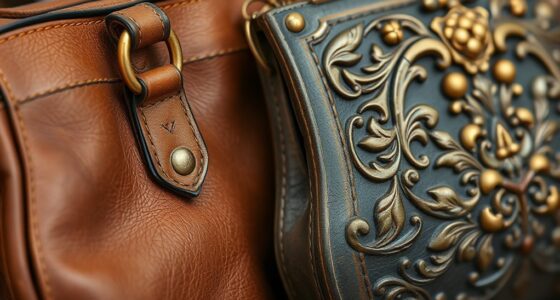The crossbody bag started as a practical item made from animal hides and woven fibers, used by ancient travelers for easy access and security. Through the Middle Ages and Renaissance, it grew more ornate, symbolizing status or faith. During the Industrial Revolution, it became more durable and ergonomic, then evolved into a fashion icon in the 20th century—representing independence and style. Today, it blends functionality with trendy designs, and you can explore how its rich history continues to shape modern fashion.
Key Takeaways
- Crossbody bags originated in ancient times as practical containers with cultural and symbolic significance.
- During the Middle Ages, they evolved into ornate accessories carried by nobility and clergy.
- The Industrial Revolution introduced mass production, ergonomic designs, and durable materials to enhance functionality.
- In the 20th century, they became symbols of cultural identity, rebellion, and fashion innovation.
- Today, crossbody bags blend style and practicality with modern materials, remaining a versatile fashion staple.
Ancient Origins and Early Uses

Long before modern fashion, people used simple containers to carry their essentials, making the origins of the crossbody bag deeply rooted in practicality. These early carriers often held symbolic meaning, representing status or cultural identity. Material innovation played a key role, as early artisans crafted bags from animal hides, woven fibers, and rudimentary textiles, enhancing durability and portability. The design was straightforward, with straps for easy wear across the body, ensuring quick access and security. These practical origins laid the groundwork for later styles, blending function with symbolism. Over time, these simple containers evolved into more sophisticated forms, but their core purpose—convenience and meaning—remained central. The early use of these bags reflects both ingenuity and the importance of carrying essentials in a way that connected to cultural identity, highlighting the enduring significance of functional design. Additionally, the evolution of materials used in crafting these carriers demonstrates how Material innovation has continually influenced their development and popularity throughout history, driven by advancements in textile technology.
Evolution Through the Middle Ages and Renaissance

During the Middle Ages and Renaissance, the crossbody bag continued to evolve, reflecting changing social and functional needs. Soldiers and travelers carried small pouches or satchels, often attached to belts or woven into their clothing, ensuring quick access. These pouches sometimes drew inspiration from medieval armor, mimicking the protective qualities with sturdy materials. Religious symbolism also influenced designs, with pouches featuring crosses or sacred motifs, emphasizing spiritual devotion. As fashion advanced, these bags became more ornate, serving both practical and decorative purposes. Nobility and clergy used them to carry essentials or display status, integrating symbols of faith into everyday life. This period marked a shift from purely utilitarian objects to items that expressed identity, faith, and social standing through their design and symbolism.
The Industrial Revolution and Functional Designs

Have you ever wondered how the Industrial Revolution transformed everyday accessories like the crossbody bag? During this period, industrial innovation led to mass production, making bags more accessible and affordable. Designers focused on ergonomic design to improve comfort and functionality, tailoring bags to fit the human body better. You’ll notice that crossbody bags became more streamlined, with adjustable straps and compartments that served practical needs. This shift was driven by a demand for efficiency and ease of use in a rapidly changing world. Fabrics and hardware also improved, adding durability and style. As a result, the traditional messenger bag evolved into a versatile, functional accessory that could keep up with your busy lifestyle, setting the stage for its future popularity. Additionally, the rise of animated movies and the influence of pop culture helped shape the aesthetic appeal of modern crossbody bags, blending functionality with fashion. The integration of innovative materials and manufacturing techniques further propelled their widespread adoption and design diversity, highlighting the importance of appliance maintenance plans in ensuring durability and performance over time. Moreover, advancements in ergonomic design principles contributed to making these bags more comfortable for everyday use, reflecting a focus on user-centered innovation.
The Rise of Fashion and Cultural Significance in the 20th Century
As the industrial advances made crossbody bags more practical and accessible, their role in fashion and culture started to evolve considerably in the 20th century. You see, they became symbols of cultural identity and fashion innovation, reflecting social movements and changing trends. In the 1960s and 70s, designers embraced the crossbody as a statement piece, blending practicality with style. The bag’s versatility allowed it to symbolize independence and freedom, especially among youth and counterculture groups. As fashion evolved, the crossbody transformed from a utilitarian item into a cultural icon, often representing rebellion or sophistication depending on its design. Its widespread adoption highlights how functional accessories can carry deep cultural symbolism, shaping and reflecting societal shifts throughout the century. Embracing minimalist design, many brands streamlined the silhouette, emphasizing simplicity and elegance over ornamentation. Additionally, the use of durable materials in manufacturing helped solidify the crossbody’s reputation as both fashionable and practical, reinforcing its significance in everyday life.
Contemporary Styles and the Crossbody’s Role Today

Today, the crossbody bag remains a versatile staple in contemporary fashion, adapting effortlessly to a variety of styles and functions. Material innovations like lightweight nylon, eco-friendly leather, and durable synthetics keep these bags both stylish and practical. Celebrity influences play a significant role in shaping trends, with icons frequently seen sporting sleek, minimalist designs or bold, statement pieces. This blend of innovative materials and celebrity endorsements guarantees the crossbody stays relevant, whether you’re dressing up for a night out or opting for a casual, everyday look. Its hands-free convenience and adaptability make it a favorite across all age groups and fashion sensibilities. Additionally, the influence of Steampunk and Victoriana designs introduces unique, vintage-inspired elements that can elevate the aesthetic of modern crossbody bags. The history of the crossbody as a functional item has contributed to its enduring popularity, making it a timeless accessory. As a result, the crossbody continues to evolve, balancing functionality with style in today’s fast-paced world, with material versatility further supporting its widespread appeal. Exploring design innovation within fashion accessories can lead to even more personalized and creative options.
Frequently Asked Questions
How Did the Materials Used in Crossbody Bags Change Over Time?
You’ll notice how material evolution has influenced crossbody bags, reflecting textile diversity over time. Initially, leather and sturdy fabrics were common, offering durability. Today, you see a mix of synthetic materials, eco-friendly textiles, and innovative fabrics that prioritize style and sustainability. This shift allows you to choose bags that suit your lifestyle, blending function with fashion, and showcasing the diverse range of materials used in modern designs.
Were Crossbody Bags Popular in Non-Western Cultures Historically?
You might notice that crossbody bags have cultural variations worldwide, and historically, they held traditional uses beyond Western fashion. In many non-western cultures, these bags served practical purposes like carrying tools, money, or personal items during daily activities or ceremonies. Their design often reflected cultural symbols and customs, making them more than just accessories—they were essential parts of traditional attire and functional tools for everyday life.
What Are Some Iconic Figures Associated With Popularizing Crossbody Styles?
You’ll notice that designer collaborations and celebrity endorsements have played key roles in popularizing crossbody styles. When famous figures showcase these bags, it instantly boosts their appeal and trendiness. Designers like Louis Vuitton and Gucci have also elevated the style through innovative collections. Their influence, combined with celebrity endorsements, makes the crossbody bag a must-have accessory, cementing its status as a fashion staple in modern style.
How Do Crossbody Bags Vary Across Different Age Groups Globally?
You’ll notice that crossbody bags differ drastically across diverse demographics. Younger users often favor fun, fashionable, and functional styles, while older individuals prefer practical, polished, and timeless designs. Globally, regional preferences influence sizes, materials, and details—think sleek, sophisticated styles in the West versus vibrant, versatile options in Asia. These age-specific styles and regional preferences shape how you choose a crossbody that suits your style, needs, and setting.
What Environmental Impacts Have Influenced Modern Crossbody Bag Manufacturing?
You’re aware that environmental impacts shape modern crossbody bag manufacturing. You see brands adopting sustainable materials like recycled fabrics and eco-friendly production processes to reduce waste and carbon footprints. By choosing bags made with these eco-conscious methods, you help lessen environmental harm. This shift promotes sustainability, encouraging the industry to prioritize eco-friendly practices, and ultimately, supports a greener future for fashion.
Conclusion
From its humble beginnings as a messenger’s tool to a fashion icon, the crossbody bag has traveled through centuries of style and practicality. Like a trusted companion that adapts to every era, it continues to blend function with fashion. As you carry one today, remember you’re holding a piece of history that’s as timeless as it is versatile, effortlessly bridging the past and present in a single, elegant strap.








